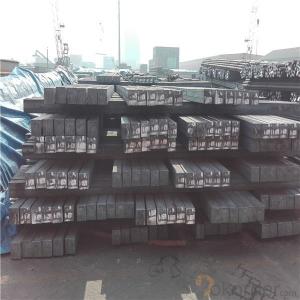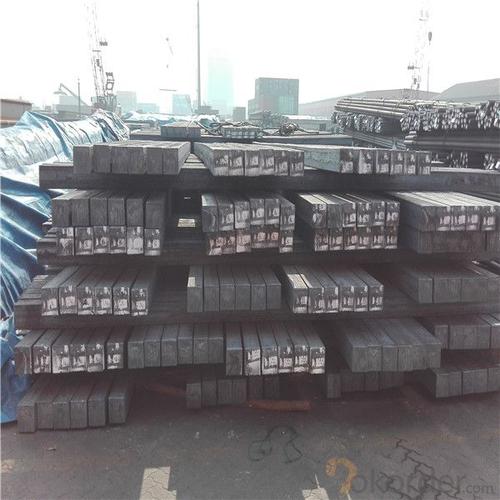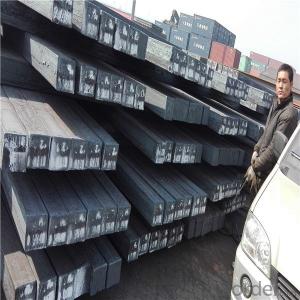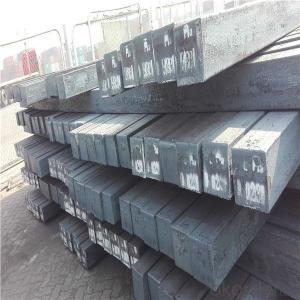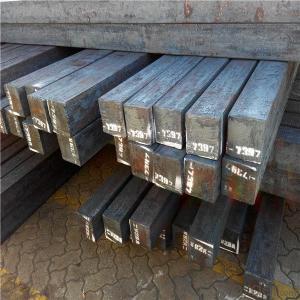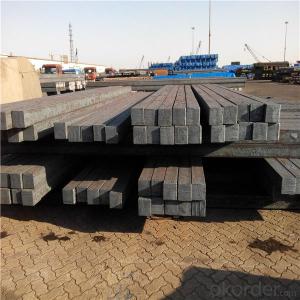Mild steel billet low price hot sale different grade
- Loading Port:
- Tianjin
- Payment Terms:
- TT OR LC
- Min Order Qty:
- 1000 m.t.
- Supply Capability:
- 17532 m.t./month
OKorder Service Pledge
OKorder Financial Service
You Might Also Like
Specification
Steel billet(ingot) by cogging or breakdown of semi-finished products, is the raw material of all kinds of steel mill. Billet section of square, round, flat, rectangular
and abnormity of several kinds of, mainly related to the shape of rolled products.
Used for the plant, the bridge,shipment building high-rise building construction,lifting and transportation machinery, equipment manufracturing base building the
support foundation pile manufacturing.
Qaulity:own factory, stable quality
Tolerance: Strictly according to the G/B and JIS standard
Delivery time: within 45 days after receiving the L/C or advanced T/T payment.
Payment terms: 100%Irrevercable L/C at sight or T/T
Gade:
Standard | C(%) | Mn(%) | S(%) | P(%) | Si(%) |
Q195 | ≤0.12 | ≤0.50 | ≤0.040 | ≤0.035 | ≤0.30 |
Q235 | ≤0.20 | ≤1.40 | ≤0.045 | ≤0.045 | ≤0.35 |
Q275 | ≤0.22 | ≤1.50 | ≤0.045 | ≤0.045 | ≤0.35 |
20MnSi | 0.17-0.25 | 1.2-1.6 | ≤ 0.050 | ≤ 0.050 | 0.40-0.80 |
3SP | 0.14-0.22 | 0.40-0.85 | ≤ 0.050 | ≤ 0.040 | 0.05-0.15 |
5SP | 0.28-0.37 | 0.50-1.00 | ≤ 0.050 | ≤ 0.040 | 0.15-0.30 |
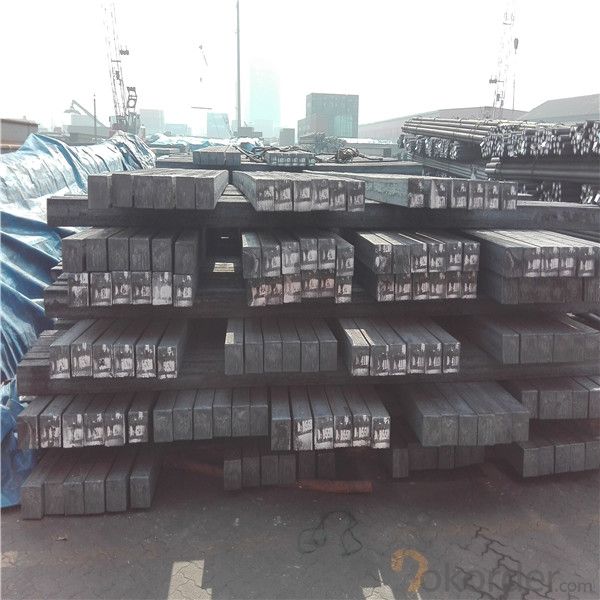
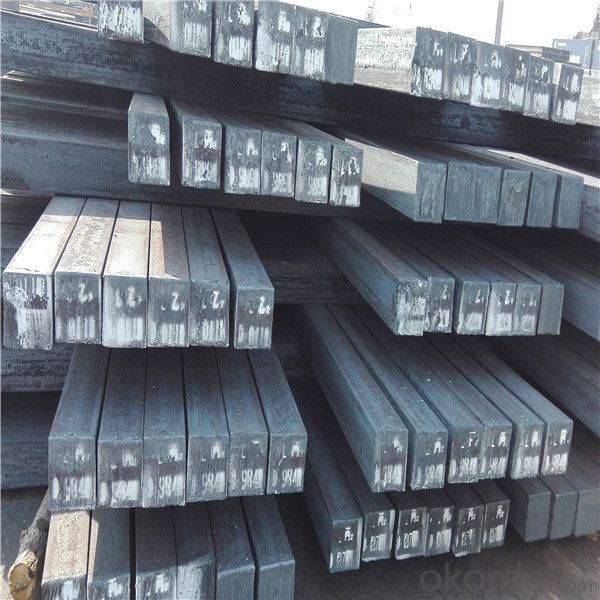
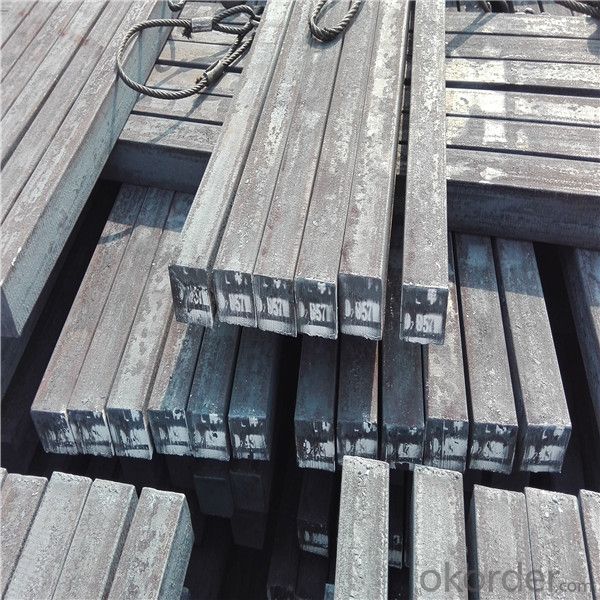
Our service :
We have a plant and professional team to provide our best service, from the start of production until the
loading into the vessel, we have a complete quality follow up procedure, to assure our products arrives to the customer with satisfaction. Welcome new and old customers
to contact us for future business relationships! We will give you a surpise price.
Packing :
Within 30 days
1.Standard export package
2.In bundles with steel strips
3.As the requirements of the customers
FAQ:
Q: What is payment terms?
A: FOB 30% T/T IN ADVANCE AS DEPOSIT AND 70% T/T BEFORE SHIPMENT
CIF and CFR 30% T/T IN ADVANCE AS DEPOSIT AND 70% T/T AS THE COPY OF B/L OR L/C AT SIGHT
Q:How to guarantee the quality of the products?
A:We have established the international advanced quality management system,every link from raw material
to final product we have strict quality test;We resolutely put an end to unqualified products flowing into the market.
At the same time, we will provide necessary follow-up service assurance.
Q:How long can we receive the product after purchase?
A :In the purchase of product within three working days, We will arrange the factory delivery as soon as possible.
The pecific time of receiving is related to the state and position of customers.
- Q: What are the challenges faced in the production of steel billets?
- There are several challenges faced in the production of steel billets. One of the main challenges is the sourcing of raw materials. Steel billets are typically produced from iron ore, which needs to be mined and processed before it can be used. The availability and quality of iron ore can vary, making it challenging to secure a consistent supply. Another challenge is the energy-intensive nature of steel production. The process of converting iron ore into steel billets requires significant amounts of energy, mainly in the form of electricity and fossil fuels. This can lead to high production costs and contribute to environmental concerns, such as greenhouse gas emissions. Additionally, the production of steel billets involves complex metallurgical processes. The steel needs to be heated to high temperatures and undergo various treatments to achieve the desired properties. Ensuring consistent quality and meeting specific customer requirements can be challenging, as any deviations in the production process can affect the final product's performance. Maintaining a safe working environment is also a significant challenge in steel billet production. The production process involves handling heavy machinery, molten metal, and potentially hazardous chemicals. Effective safety measures and protocols need to be implemented to protect workers and prevent accidents. Lastly, the market dynamics and competition in the steel industry pose challenges in the production of steel billets. Fluctuating demand, changes in customer preferences, and price volatility can impact production planning and profitability. Steel producers need to stay competitive by continuously improving efficiency, reducing costs, and adapting to market trends. Overall, the production of steel billets faces challenges related to raw material sourcing, energy consumption, metallurgical processes, safety, and market dynamics. Overcoming these challenges requires a combination of technological advancements, efficient operations, and strategic decision-making to ensure a sustainable and successful production process.
- Q: How are steel billets cut into desired lengths?
- Steel billets are commonly cut into desired lengths using various cutting techniques. One of the most commonly used methods is saw cutting. In this process, a high-speed circular saw equipped with a carbide or diamond-tipped blade is used to cut through the steel billet. The billet is securely clamped in place, and the saw blade is brought down onto the billet, slicing through it to create the desired length. Another method used is torch cutting, which involves the use of an oxy-fuel torch. The torch produces a high-temperature flame that is directed onto the billet, melting and cutting through the steel. Torch cutting is often used for larger and thicker steel billets, as it allows for more flexibility in cutting irregular shapes or angles. Additionally, plasma cutting is another technique employed for cutting steel billets. Plasma cutting involves the use of a plasma torch that generates an electrically conductive plasma arc. This arc melts the steel and blows away the molten metal, resulting in a precise and clean cut. Plasma cutting is particularly useful for cutting through thicker steel billets or for intricate shapes and designs. Overall, the cutting technique used to cut steel billets into desired lengths depends on factors such as the size and thickness of the billet, the desired precision and accuracy, and the specific requirements of the end product.
- Q: What is the role of steel billets in the automotive industry?
- Steel billets are of utmost importance in the automotive industry as they are crucial in the production of various vehicle components and parts. Essentially, steel billets are semi-finished steel products that undergo further processing to achieve the desired shape and size necessary for automotive applications. One primary application of steel billets in the automotive sector is in the production of engine and transmission components. These components, including crankshafts, connecting rods, camshafts, gears, and others that require high strength and durability, rely on steel billets as raw material for forging or casting. This ensures that they can withstand the demanding conditions of engine operation. Another significant use of steel billets in the automotive industry is for the manufacturing of structural components. These components, such as chassis frames, suspension parts, and body panels, need to possess high strength and stiffness to provide safety and rigidity to the vehicle. Steel billets undergo various techniques like hot rolling, cold rolling, or extrusion to produce the necessary forms and shapes required for these structural components. Furthermore, steel billets are also employed in the production of essential fasteners like bolts, nuts, and screws, which are crucial for assembling different parts of the vehicle. These fasteners must possess excellent tensile strength and resistance to vibration and corrosion, making steel billets an ideal choice for their manufacture. Additionally, steel billets find application in the production of various other automotive components, including axles, wheel hubs, brake discs, and steering system parts. All these components require the superior mechanical properties offered by steel billets, such as high strength, toughness, and resistance to wear and tear. In conclusion, steel billets play a vital role in the automotive industry as they serve as raw material for the production of engine and transmission components, structural components, fasteners, and other crucial parts. Their exceptional mechanical properties make them an ideal choice for applications that demand high strength, durability, and reliability, ensuring the safety and performance of vehicles on the road.
- Q: How are steel billets used in the manufacturing of medical devices?
- The manufacturing of medical devices relies on steel billets in multiple ways. Surgical instruments, like scalpels, forceps, and scissors, use steel billets as a raw material. These instruments demand strength, durability, and corrosion resistance, qualities that steel billets possess. Steel billets also find use in the production of implants, such as joint replacements and dental implants. These implants must withstand the body's load and stress, making steel billets an ideal material due to their outstanding mechanical properties. Furthermore, medical equipment like hospital beds, wheelchairs, and surgical tables are manufactured using steel billets. These devices require a robust structure, and steel billets provide the necessary strength and stability. Moreover, steel billets are integral to the manufacturing of medical equipment components, such as brackets, frames, and supports. These components are crucial for the proper functioning and stability of medical devices, and steel billets are often selected for their high machinability and weldability. In summary, steel billets play a vital role as a raw material in the manufacturing of diverse medical devices. Their strength, durability, corrosion resistance, and other mechanical properties make them an excellent choice for producing surgical instruments, implants, medical equipment, and their components.
- Q: How are steel billets used in the production of construction equipment?
- Construction equipment production relies heavily on the use of steel billets. These semi-finished steel forms are essential in creating different components for construction equipment. The process of continuous casting is typically used to manufacture these billets, where molten steel is solidified in molds to form solid rectangular or square shapes. After obtaining steel billets, further processing is carried out to transform them into the desired construction equipment parts. This involves shaping, cutting, and machining the billets to create components like gears, shafts, axles, and structural frames. The versatility of steel allows these components to be customized to meet the specific requirements of different construction equipment. The utilization of steel billets in construction equipment production offers numerous advantages. Firstly, steel is known for its exceptional strength and durability, making it a perfect choice for heavy-duty applications. By incorporating steel billets, construction equipment manufacturers can ensure that their products can withstand the demanding conditions of construction sites and provide long-lasting performance. Additionally, steel billets can be easily welded, enabling the assembly of complex structures and components. This welding capability is crucial in construction equipment production, where multiple parts need to be securely joined together to create a robust and reliable machine. Furthermore, steel billets possess excellent machinability, allowing them to be easily shaped and formed into desired dimensions. This facilitates the precise manufacturing of intricate components, enhancing the overall performance and functionality of the construction equipment. Lastly, steel billets are readily available in a wide range of grades and compositions. This enables manufacturers to select the most suitable steel alloy for their specific construction equipment applications. This flexibility allows for the optimization of the equipment's performance, weight, and cost-effectiveness. In conclusion, steel billets play a crucial role in construction equipment production as they serve as the raw material for various components. Their strength, durability, weldability, machinability, and range of available alloys make them an ideal choice for manufacturing construction equipment that can withstand the demanding conditions of construction sites and deliver long-lasting performance.
- Q: How are steel billets used in the production of automotive frames?
- Steel billets are used in the production of automotive frames as they are heated and shaped into desired forms, such as beams or plates, which are then welded together to create the structural framework of a vehicle.
- Q: How are steel billets used in the manufacturing of construction cranes?
- Steel billets are an essential component in the manufacturing of construction cranes. These billets, which are semi-finished metal forms, are typically made from molten steel that is cast into rectangular or square shapes. They are then further processed and transformed into various crane components. One crucial use of steel billets in the construction crane manufacturing process is for the production of structural elements. These billets are heated and rolled into long, slender beams or columns that form the backbone of the crane's structure. These beams provide the necessary strength and rigidity to support heavy loads and withstand the stresses encountered during crane operation. By using steel billets, manufacturers can ensure that the structural components of construction cranes possess the required durability and load-bearing capacity. Moreover, steel billets are also utilized in the production of crane boom sections. The boom is the extended arm of the crane that allows it to reach high elevations and transport heavy materials. Steel billets are reheated and shaped into cylindrical or rectangular sections, which are then welded together to form an elongated boom structure. The use of steel billets ensures that the boom sections have the necessary strength and stiffness to safely lift and maneuver heavy loads. Additionally, steel billets are employed in the manufacturing of other crane components such as pulleys, gears, and various fittings. These billets are forged, machined, or cast into the required shapes and sizes to create the intricate parts that enable the crane to function smoothly and efficiently. The high strength and versatility of steel make it an ideal material for these critical components. In summary, steel billets play a vital role in the manufacturing of construction cranes by providing the necessary raw material for the production of structural elements, boom sections, and other crucial components. Their strength, durability, and versatility make them an ideal choice for constructing cranes that can handle heavy loads and withstand the demanding conditions of construction sites.
- Q: What are the different surface treatments applied to alloy steel billets?
- Enhancing the properties and performance of alloy steel billets can be achieved through various surface treatments. One commonly used treatment involves bombarding the billet surface with small metal or ceramic particles at high velocity, a process known as shot blasting. This effectively eliminates impurities and contaminants, resulting in a clean and uniform surface finish. Additionally, shot blasting promotes the adhesion of subsequent coatings or treatments. Another method, known as pickling, entails immersing the billets in an acid solution to remove oxides and scale from the surface. This not only improves the surface quality but also eliminates any defects, preparing the billets for further processing or treatments. Heat treatment is a popular surface treatment for alloy steel billets. By subjecting the billets to controlled heating and cooling processes, their microstructure can be altered, leading to improved mechanical properties. This treatment can enhance the hardness, strength, and toughness of the billets, rendering them more suitable for specific applications. Furthermore, alloy steel billets can be coated with protective coatings to enhance corrosion resistance and durability. Common techniques include hot-dip galvanizing, electroplating, and painting. These coatings serve as a barrier between the alloy steel surface and the environment, effectively preventing corrosion and extending the lifespan of the billets. To summarize, shot blasting, pickling, heat treatment, and protective coatings are among the various surface treatments applied to alloy steel billets. These treatments enhance surface quality, improve mechanical properties, and protect against corrosion, ensuring optimal performance in diverse applications.
- Q: What are the different types of steel billet reheating furnaces?
- There are several types of steel billet reheating furnaces, including walking beam furnaces, pusher furnaces, rotary hearth furnaces, and roller hearth furnaces. Each type has its own advantages and uses, depending on the specific requirements of the steel production process.
- Q: What are the main disadvantages of using steel billets?
- One of the main disadvantages of using steel billets is their high cost. Steel billets require significant energy and resources to produce, which can lead to higher manufacturing expenses. Additionally, steel billets are heavy and difficult to transport, resulting in higher shipping costs. Another disadvantage is the limited availability of certain steel grades, leading to potential supply chain challenges. Finally, steel billets are prone to corrosion if not properly protected, requiring additional maintenance and protection measures.
Send your message to us
Mild steel billet low price hot sale different grade
- Loading Port:
- Tianjin
- Payment Terms:
- TT OR LC
- Min Order Qty:
- 1000 m.t.
- Supply Capability:
- 17532 m.t./month
OKorder Service Pledge
OKorder Financial Service
Similar products
Hot products
Hot Searches
Related keywords
